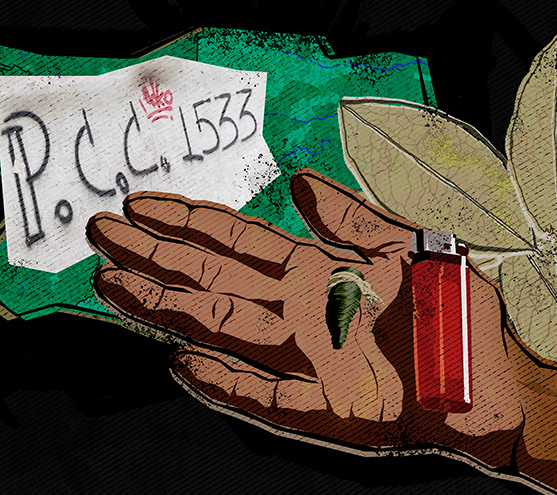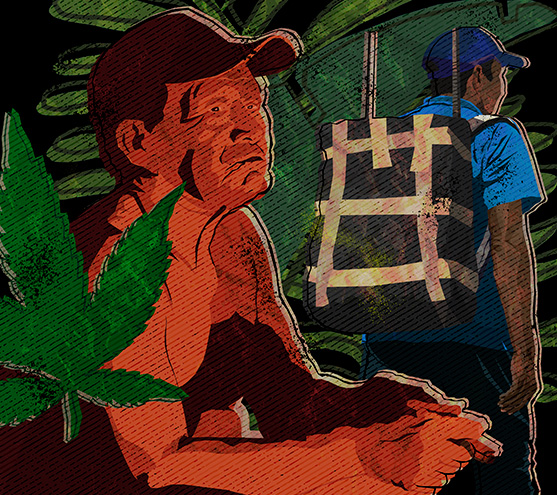The notorious Brazilian gang Comando Vermelho has seized control of the cocaine trade in Peru’s Ucayali region.
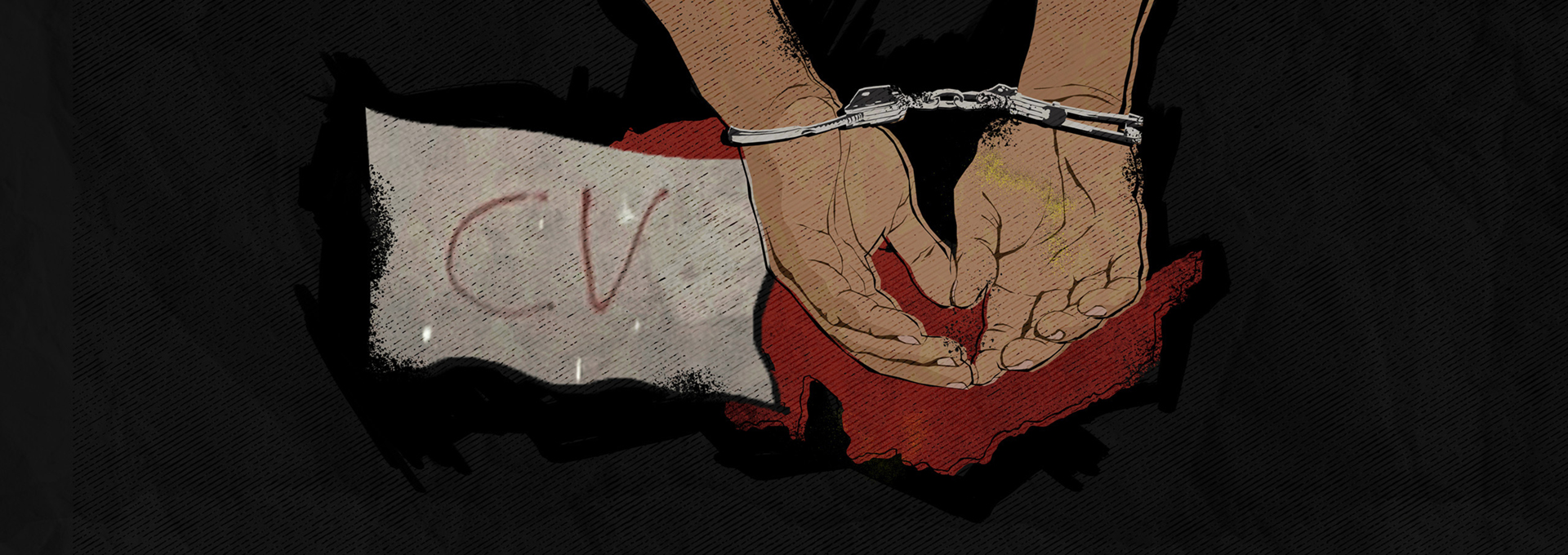
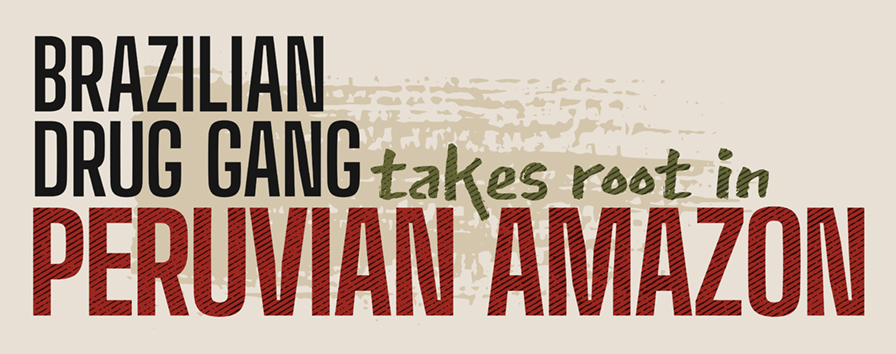
By Pamela Huerta and Iván Brehaut
Four prisoners just over five feet tall, very young and agile as acrobats, are pitching a makeshift roof made of black sacks in the main patio of the prison in Pucallpa, a city of some 325,000 people that is the capital of Peru’s eastern Amazonian region of Ucayali. They stretch, twist, lift, hang and tie as though the movements were choreographed, creating an area of shade for a visitor.
Beneath the improvised tarpaulin, they arrange a table and two plastic chairs. A few steps away, painted on the polished floor, is the Brazilian flag. Solitary, it stands out. It is a sign of the hegemony of the Comando Vermelho (Red Command), a criminal organization known simply as the CV, whose name people are afraid to say aloud.
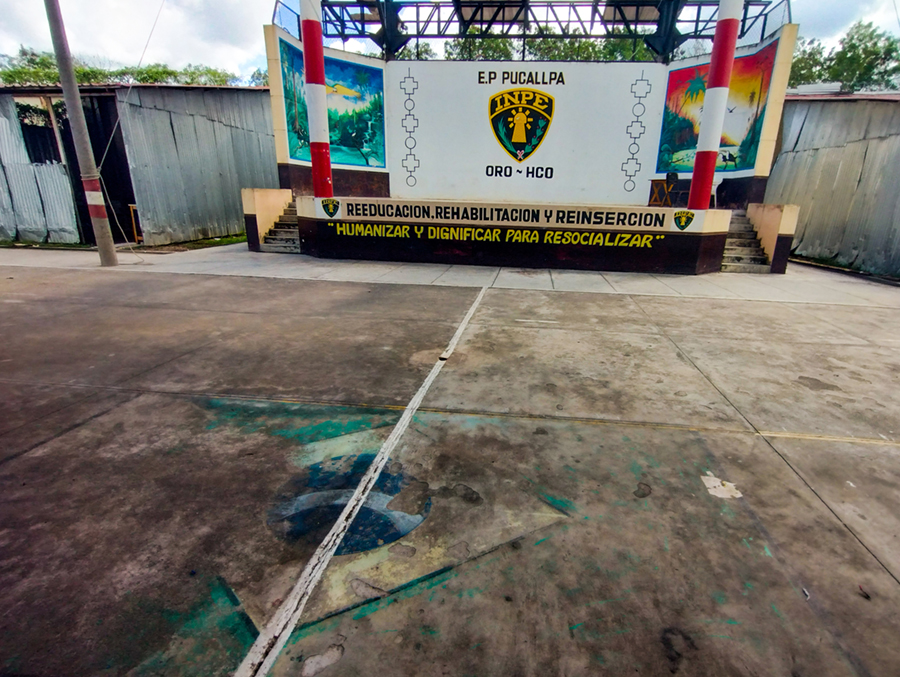
“There are ‘reds’ here, but I don’t know them,” one tells a visiting reporter. How does he know they are members of CV? “That’s what they say on the news. I don’t know anything. In my cell block there’s only one,” he adds nervously.
He won’t say more and asks to change the subject, because those people are dangerous. “It’s better not to get involved with them,” he warns, while casting a covert glance at the tops of the cell blocks surrounding the patio. The prison currently houses 2,531 inmates, 2,418 men and 113 women, more than three times its official capacity of 800.
The CV is one of the most dangerous criminal organizations in Brazil. It has its roots in prison uprisings in the 1970s, which sought improved conditions in a now-defunct prison in Rio de Janeiro, but it soon morphed into a criminal organization that has made drug trafficking one of its main economic activities. The group began to take control of strategic cocaine trafficking routes, especially on the borders of Peru and Colombia. Tabatinga, the Amazonian city located at the triple border shared by those two countries and Brazil, was one of its key positions.
Presence of Organized Crime and Armed Groups
To build this database, we consulted primary sources and documents in all the Amazonian border municipalities of Brazil, Colombia, Venezuela, Peru, Ecuador and Bolivia.
That changed in 2020, when, in a quest for absolute control, it engaged in a bloody dispute with two other Brazilian crime groups, the Familia do Norte and the Primeiro Comando da Capital. All were weakened by the battle, allowing the rise of a new group of dissidents from the three gangs, who now operate as a consortium known as Os Crias in Portuguese and Las Crías in Spanish — terms meaning “The Kids.”
That same year, the world was paralyzed by the COVID-19 pandemic, and global markets, including illegal ones, were critically affected. The CV, its dominion reduced, shifted toward Ucayali, a Peruvian region bordering Brazil where illicit cultivation of coca, the main ingredient in cocaine, is expanding.
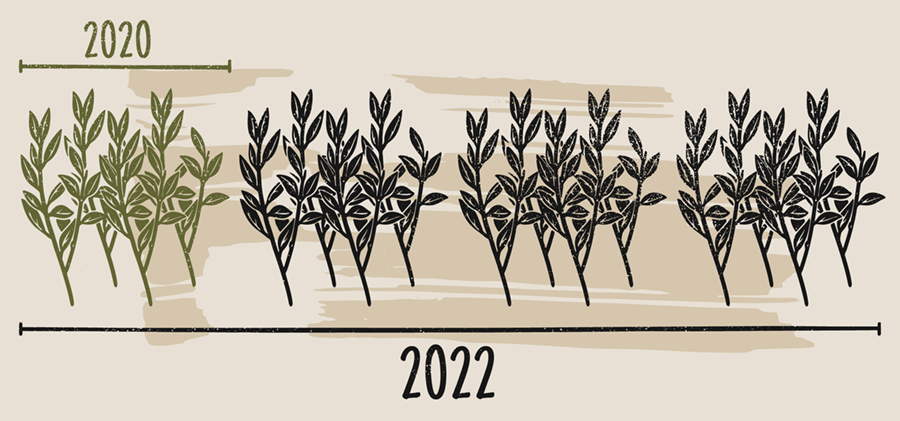
According to recent figures from Peru’s National Commission for Development and Life without Drugs (DEVIDA), in 2022 there were 14,531 hectares (56 square miles) of coca crops in the region,
NEARLY 4 TIMES THE AREA RECORDED IN 2020, THE YEAR THE CV’s PRESENCE WAS DETECTED.
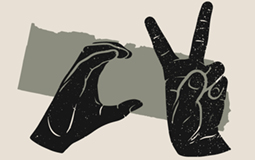
THE COMANDO VERMELHO’S CONQUEST
María* is a young Shipibo-Konibo woman from an Indigenous community in the district of Callería, in Ucayali’s Coronel Portillo province. She was 19 when she met the man she still considers the love of her life. At the time, she had a partner and two children. “I was 12 when I got pregnant with the first,” she recalls. She was just a child, though she doesn’t think of it that way. She speaks in similar naive terms when she remembers the CV member who she says courted her and convinced her to get a tattoo of his name on her forearm, adorned with a heart and stretching nearly from the elbow to the wrist.
She’s one of the 113 women in the prison on an early morning in April. Her red hair is tied high in a tousled topknot, and she’s wearing a print blouse that bares her shoulders. Her gold hoop earrings contrast with the pink lipstick she applied that morning.
Twenty-four now, she has spent the past three years in the Pucallpa prison for drug trafficking. They caught her trying to smuggle cocaine base paste into the prison for her brother-in-law, who was close to the man who became her boyfriend. “It was unfair,” she says. “I didn’t know. I trusted him, because he was family.”
In her home community, coca is grown especially by those who speak Spanish best and can establish connections with mestizos — people who are not Indigenous. There aren’t many options for making a living, she says. “They choose our communities mainly because, since they’re so far away, the police never go there. Nobody goes there.”
That area where no one goes, an area that is remote even for the government, and which law enforcement sources say is controlled by the CV, is the region around the Abujao River and the parallel Utiquinía watershed, southeast of Pucallpa. Most of the communities are Indigenous, and people who have worked in the area say no one enters or leaves without the CV knowing.
“It’s been around six months since I was last there. It’s expensive to go, because of the cost of fuel. But I can enter and leave because I’m from there. I have my farm there, and I have family there,” says a farmer from Abujao who lives in Pucallpa now.
If you go, they won’t let you enter, and they might not let you leave. The Brazilians control everything there.
— Farmer from Abujao
Former regional government officials, who requested anonymity, confirm his account, saying they have been blocked and threatened by the CV when they have tried to start projects in the area.
Passenger boats travel to the Abujao River from Pucallpa’s port on the Ucayali River, a trip that takes between 10 and 15 hours, depending on the time of year. To a visitor, the lowland scenery of forest and water looks the same, but an experienced boat pilot recognizes the subtle landmarks. In the dry season, when water levels are low, only canoes can navigate upstream on the Abujao and other tributaries of the Ucayali.
Sources in the National Police’s regional intelligence office say they began seeing Brazilians connected with the CV in the area in 2015, but it was in 2020 that they were able to confirm that the criminal organization had taken root in the region. They are cautious when identifying members of the CV, because some criminals, when arrested, will claim to belong to the group to inspire fear, they say.
Nevertheless, anti-narcotics police identified as members of the CV a group of drug traffickers involved in an armed confrontation with 15 police officers during an operation on August 2 in Callería, the district that includes the Abujao watershed. One officer was wounded, and after the traffickers fled, police confiscated cocaine, firearms, ammunition and a cell phone.
Drug trafficking routes in the Ucayali region
Drugs are transported by river to the triple border shared by Peru, Colombia and Brazil, and by “backpackers” overland to the Brazilian border.
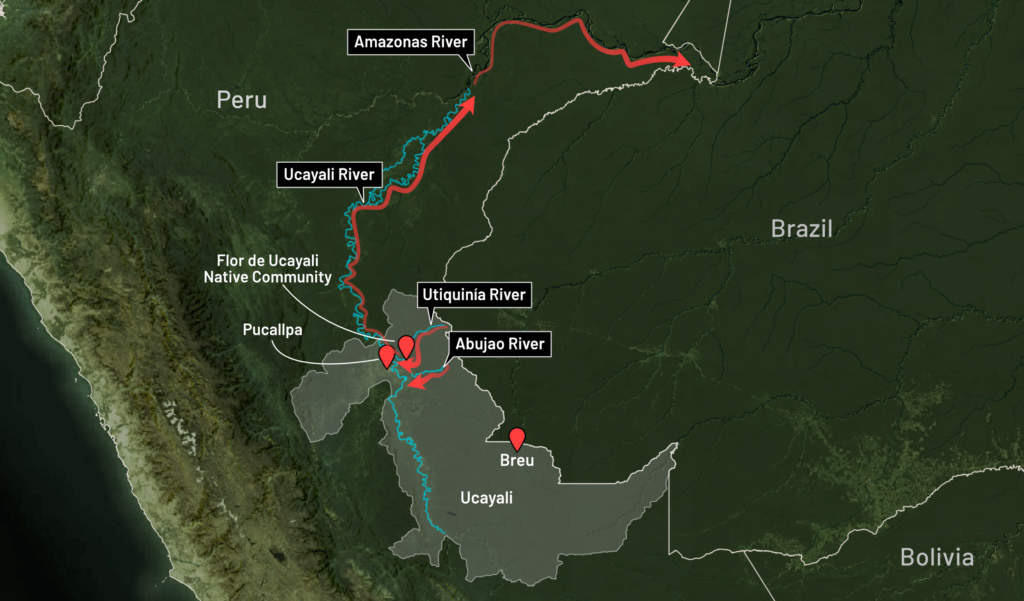
María met the man whose tattoo she bears through her brothers, who began harvesting coca for a local drug trafficker when they were 12 years old. The boys don’t know how to read or write, so they earn money picking coca leaves until their hands bleed. At first, they introduced him as José. Later she discovered that was not his real name. She says he treated her like a princess, although she describes him as an attractive man with no compunctions.
“I saw him every month, every time he came to pick up his shipment. He transported cocaine in bricks, in his wooden boat, so the police wouldn’t suspect anything, you know? So he let me know and I’d go to where he was staying. I’d stay three days and then he’d leave with his shipment,” she says, a look of nostalgia.
According to law enforcement officials and other sources, who requested anonymity, the Abujao region is a liberated area controlled entirely by the CV, where cocaine base paste is produced and then transported by river to Brazil. One area controlled by the group centers around the rural community of Nuevo Utiquinía, on the Utiquinía River. Sources say it is an important point for stockpiling drugs for shipment, but it is difficult for authorities to gain access.
“The Brazilians hire residents of the community for their operations. Sometimes you see them walking through the community with their sacks or moving money. Everyone knows what they’re involved in, but you need to keep quiet or they’ll send someone to make you disappear. That’s what the community members themselves say over lunch or dinner,” says one former public servant who worked in the area around four years ago.
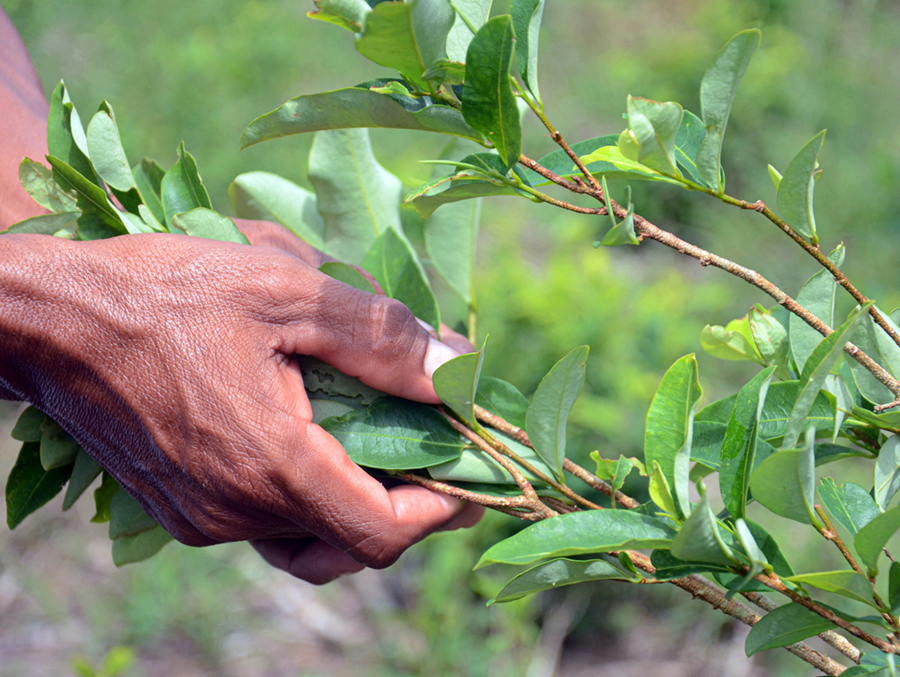
Col. Luis Wong Briceño, head of the Ucayali office of the National Police’s anti-drug unit, DIRANDRO, says there have been various police operations in the Shipibo-Konibo community of Flor de Ucayali on the Utiquinía River. Laboratories are destroyed, coca crops are eradicated, but they keep doing it,” he says.
According to DEVIDA’s figures, Flor de Ucayali had 219 hectares (nearly one square mile) of coca crops in 2022, up 34% from 2020.
DEVIDA has no statistics for other Indigenous communities in Ucayali, or for other rural communities known as campesino communities. According to Carlos Figueroa Henostroza, executive president of DEVIDA, the agency only monitors communities that request its assistance, and in Ucayali it works only with Flor de Ucayali. Acceptance of the agency’s help in developing other sources of income, however, does not necessarily mean that drug trafficking does not continue.
The lack of data raises questions about the accuracy of Peru’s estimates of coca production, as well as the amount of cocaine that can be produced from it. Peru’s official information system on drugs, known as SISCOD, shows potential annual cocaine production for Ucayali only through 2020, when 35 tons were produced, according to its figures. There are no estimates for production since the CV’s presence in the region was confirmed.
Figueroa says the only way to try to eliminate the coca economy in the Abujao region would be to use the “Peru Model,” a strategy implemented in 2015, and recently revived, which involves eradication of coca crops, sanctions for illegal acts, and alternative development schemes to provide families with an income from legal sources, such as cocoa, coffee or fish farming.
“That is the only way to rescue vulnerable populations from illicit drug trafficking and include them in development,” he says.
Despite those efforts, however, Peru’s coca and cocaine production keep increasing. The remote communities most attractive to drug traffickers, where job and educational opportunities are scant or non-existent, are also far from markets for alternative crops. And no business is as profitable as drug trafficking or illegal gold mining, which has also moved into the Abujao watershed.
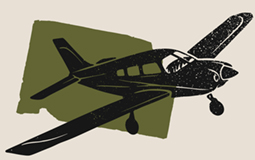
DRUGS SHIPPED BY LAND, RIVER AND AIR
In a wooden house with a palm-thatch room on the outskirts of Puerto Breu, in the eastern Yurúa district of the Ucayali region, two young men sit on the floor while another relaxes in a hammock. The three are alert to unwanted visitors. They’ve arrived from the town of Bolognesi, on the Ucayali River, traveling nearly 200 kilometers (124 miles) over the past five days, most of it on foot. Each has carried a 15-kilogram (33-pound) pack of drugs.
They’ve been doing this for the past year, they say, going part of the way on motorcycles along a rough road that is muddy and rutted, but wide enough for logging equipment. They cross swift rivers in boats. But the longest stretch of the route, through dense forest, is a trail that takes them through mud, over streams and ravines, and past huge trees and coca fields. Mosquitoes and bees are their companions along the way, feeding on their sweat and blood.
Drugs manufactured in Ucayali are smuggled out by boat, in small planes and by drug runners like these three, known in Peru as “backpackers.” According to sources in DIRANDRO, the anti-drug police, the CV mainly ships drugs down the Ucayali and Amazon rivers to towns like Tabatinga and Leticia, on the triple border with Colombia and Brazil. The same route is used by traffickers in the neighboring Loreto region. Other traffickers ship by small plane, mainly to Bolivia, from more than 70 landing strips carved out of Ucayali’s forests, the sources say. And some send smaller amounts overland with backpackers.
The house where the three men are staying near Breu belongs to a woman who lives in Pucallpa and has relatives in an Indigenous community in this area. It sits beside a red and yellow clay road that leads to the smallest and most remote of the town’s ports. From outside, the building looks abandoned, surrounded by weeds, with no electric lines or even a latrine for the visitors. The only signs of life are a few pieces of plastic hanging outside and the smoke from a small cook fire.
Two of the men are from Satipo, a town in Peru’s main coca-growing region, the Apurímac, Ene and Mantaro river valley, or VRAEM, for its Spanish initials. The third is from San Francisco, in the upper Ene Valley, the heart of that region. Two young Ashéninka men from a community in the Yurúa district, who served as guides during the last stretch of the route, leave the house when a visitor begins asking questions.
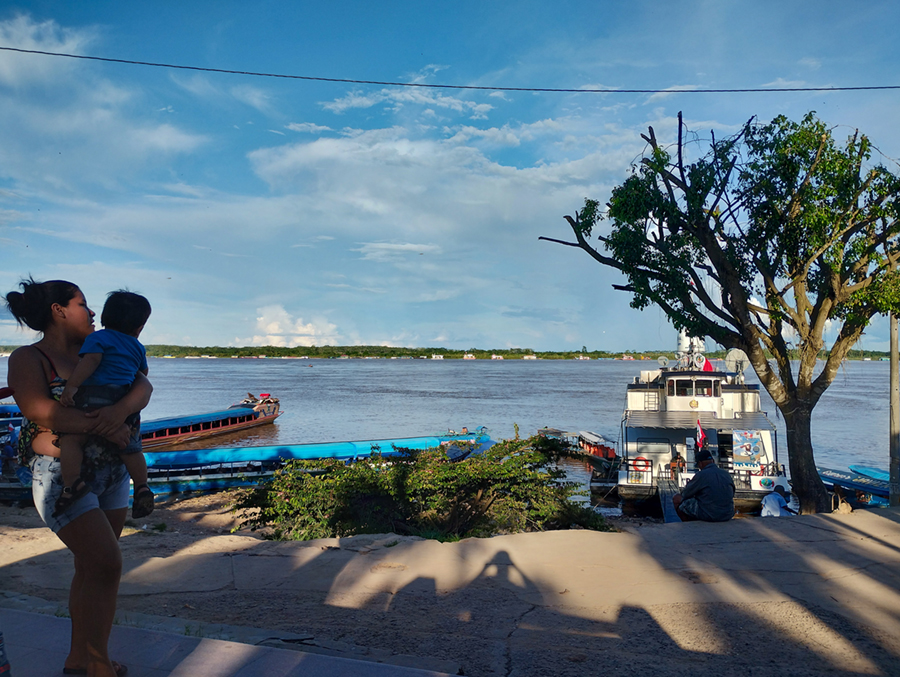
It will be a few days before their contact, a Peruvian man who delivers the drugs to Brazilian traffickers, pays them and tells them they can return home. Payment depends on the shipment, and a group of five backpackers can earn around US$2,800 for transporting 75 kilos (165 pounds) of cocaine. The pay rate depends on the distance and the weight of the load.
The three are among dozens of young men who transport drugs from production areas in Ucayali to Breu, where slim, high-powered motorboats ferry it to towns in Brazil. Based on accounts from young men who have been detained, police in Brazil have identified various points where Peruvian backpackers cross the border and traffickers stash drugs.
According to police sources, the man who received the shipment from the three young backpackers harasses local Indigenous leaders who speak out about the expansion of drug trafficking in the area. During a border gathering of Indigenous residents of Peru and Brazil in April 2022, they say, he sat outside filming participants. Police confiscated his phone and erased the photos and videos, but filed no charges.
Police and local residents say traffickers offer “samples” of drugs to young people in small towns and Indigenous communities. They also recruit young people and some adults to work as guides for drug runners. One of the young Ashéninka men says 10 hours of walking was worth 100 soles (about US$27). “What else are you going to do here?” he asks. Indeed, the only work is in subsistence agriculture or occasional temporary jobs in municipal offices, and there’s little chance of education past high school, or even grade school in some areas.
The backpackers talk about using their earnings to buy land around Breu.
“You can start a business. That way you don’t have to walk and can make money more easily, without so much pain in your legs,” one says with a laugh. Another adds, “A little bar or a shop. You can make a business out of anything. You just need the capital.”
But getting out of the drug trafficking business can be far more difficult than getting in.
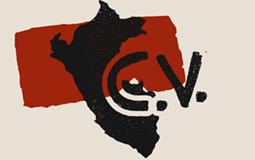
THE PERUVIAN VERMELHOS
When María “fell into disgrace,” as she refers to her imprisonment in Pucallpa, she did not entirely understand what had happened. When she put together the pieces of the puzzle that led to her five-year sentence, she realized that the man she considered her boyfriend had something to do with it, but she wasn’t sure what. She denies that she still has feelings for him and shows the ink marks where she has tried to obliterate the tattoo with which he branded her. Like crossing out a mistake, but on her skin.
Does she know what the CV is? “Of course. He also belongs to that criminal network,” she says.
“They really scare me. They’re people who don’t like lies. They’re very disciplined in what they do. They don’t use cell phones or anything like that. They simply arrive at a place and people are waiting for them,” María says of the CV. She saw it up close, but says she never got involved, out of fear and out of love. At least, that’s what she believed until she was caught.
In prison, she met another woman who was a member of the CV. They had similar stories.
“It’s dangerous to talk about them. They operate with codes,” María says, referring to the tattoos that show a person belongs to the organization. It’s one of many mechanisms the group uses to control its members.
When her friend joined the group, “They gave her a code,” or tattoo showing that she belongs to the organization, and which can always be recognized, María adds. “That code is still active, even though she’s in prison. Wherever she is, it will always be active and she must respond” if a CV member contacts her.
They use women to transport drugs. But by doing that you belong to the CV. Once you’re in, it’s not easy to get out.
— Woman in prison for drug trafficking
Sources in the National Police’s regional intelligence unit confirm that the Brazilian CV members tend to be very reserved and avoid exposing themselves. They use Peruvian operators whom they monitor closely. Besides drug trafficking, the criminal organization is involved in murder for hire and arms trafficking, according to law enforcement sources in Ucayali.
“They basically use women to transport drugs. But by doing that you belong to the CV,” María says of the role of Peruvian women in the criminal organization. When her friend is released from prison, “The vermelhos are going to know. They’re going to find her and make her do the same thing,” she adds. “Once you’re in, it’s not easy to get out.”
The CV’s control over territory in Ucayali would not be possible without Peruvians who are assimilated into the organization as producers and logistical operators in the Brazilian-led drug trafficking network. The leaders don’t leave loose ends or allow leaks. They control the entire chain, from supplies for production of cocaine base to the purchase and transportation of the merchandise.
Most of all, however, they control their members. If a local drug trafficker tries to sell his product to an organization other than the CV, they will find out and make him pay for his treason, law enforcement officials say. It’s not a matter of loyalty, but a form of control.
“They control the river routes, the chemical supplies, they have boats for logistics,” an agent in the regional police intelligence office says. “Basically, they come to Pucallpa to get supplies, they take them to the Abujao and sell them there to the patrones [drug traffickers] who manage the crops. But then the patrones have to sell them the drugs they produce, because they can’t move the drugs without [the CV] finding out. They have lookouts along the rivers and everything is reported.”
María sums it up more succinctly.
“The CV knows everything,” she says. “Being with them is like being in another prison.”
That other prison is also in Ucayali. Although it doesn’t have bars, there’s no escape. The group has turned this region into one of its centers of operation and found new adepts among the Peruvians.
Does María think it’s possible to get out of the CV?
“Not a chance,” she says. “Only by going far away. Or dead.”
* Names have been changed.
Amazon Underworld is a joint investigation of InfoAmazonia (Brazil), Armando.Info (Venezuela) and La Liga Contra el Silencio (Colombia). The work is carried out in collaboration with the Pulitzer Center’s Rainforest Investigations Network and financed by the Open Society Foundation, the U.K. Foreign, Commonwealth & Development Office and the International Union for Conservation of Nature (IUCN NL).


